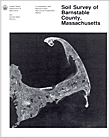The following is a map unit description from the "Soil Survey of Barnstable County, Massachusetts (Fletcher, 1993)"

HkD-Hinckley gravelly sandy loam, 15 to 35 percent slopes. This very deep, moderately steep and steep, excessively drained soil is on the sides of depressions and swales on outwash plains and on hills and ridges in areas of ice-contact deposits. It makes up about 0.4 percent (907 acres) of the survey area. It is mapped mainly in the Enfield-Merrimac-Carver general soil map unit. Areas are irregular in shape and range from 5 to 100 acres in size.
Typically, the surface is covered with an organic layer. This layer is about 2 inches of loose, undecomposed pine needles, leaves, and twigs and 1 inch of partly decomposed and well decomposed organic material. The surface layer is very friable gravelly sandy loam about 2 inches thick. The upper 1 inch is black, and the lower 1 inch of dark grayish brown. The subsoil is about 15 inches thick. The upper 1 inch is dark reddish brown, friable gravelly sandy loam; the next 7 inches is yellowish brown, friable gravelly sandy loam; and the lower 7 inches is yellowish brown, friable gravelly loamy coarse sand. The substratum extends to a depth of 65 inches or more. It is brownish yellow, loose very gravelly coarse sand in the upper 37 inches and light yellowish brown, loose gravelly coarse sand in the lower part.
Included with this soil in mapping are small areas of Carver, Merrimac, and Plymouth soils and areas where slopes are less than 15 percent. Also included are isolated areas where stones and boulders are on the surface. Included soils make up about 35 percent of this unit.
Permeability is rapid in the subsoil of the Hinckley soil and very rapid in the substratum. Available water capacity is low. Depth to the seasonal high water table is more than 6 feet.
Most areas are used as woodland. This soil is generally unsuited to cultivated crops, hay, and pasture because of the low available water capacity, the slope, and a severe hazard of erosion.
Because of the droughtiness, this soil is poorly suited to woodland. Thinning dense stands to standard stocking levels results in more vigorous tree growth. Diseased, deformed, and otherwise undesirable trees should be removed when the stands are thinned. The most common trees are eastern pitch pine, white oak, scarlet oak, black oak, and eastern white pine. Generally, these trees are of poor quality.
The slope is the main limitation if this soil is used as a site for buildings. Extensive land shaping is generally needed. Buildings and lots should be designed so that they conform to the natural slope of the land. Erosion is a severe hazard during and after construction. Planting well suited grasses as soon as possible after the surface is disturbed minimizes the erosion hazard. The droughtiness is a limitation affecting lawns and shallowrooted trees and shrubs. Adding a layer of topsoil and frequently watering during dry periods help to overcome this limitation.
This soil is poorly suited to septic tank absorption fields because of the slope and the rapid or very rapid permeability. The soil may not adequately filter the effluent. The poor filtering capacity may result in the pollution of ground water. The hazard of pollution increases with the density of housing. Installing the distribution lines on the contour or in areas that were graded during construction of the dwelling helps to overcome the slope. Precautionary measures may be necessary in some areas.